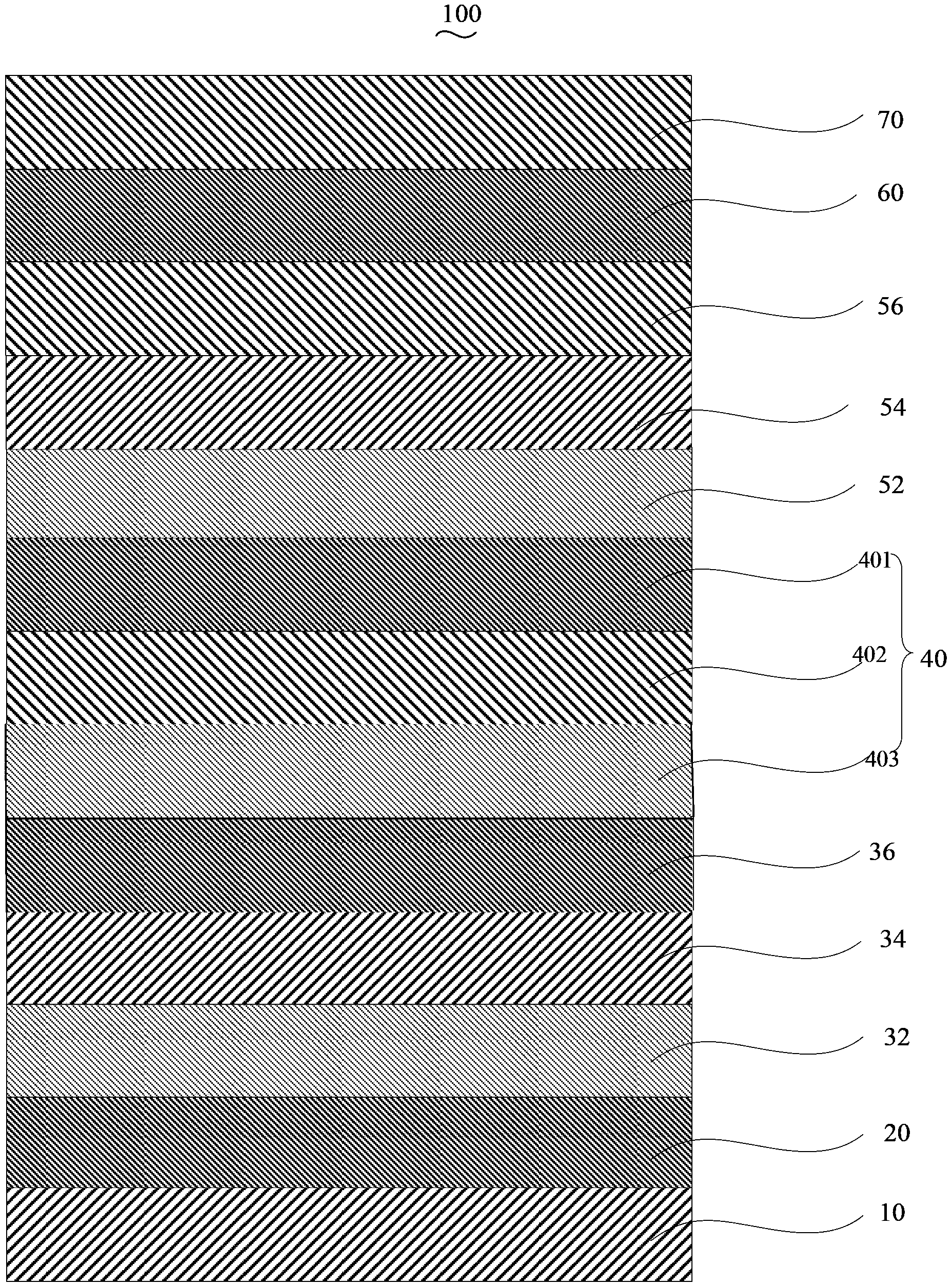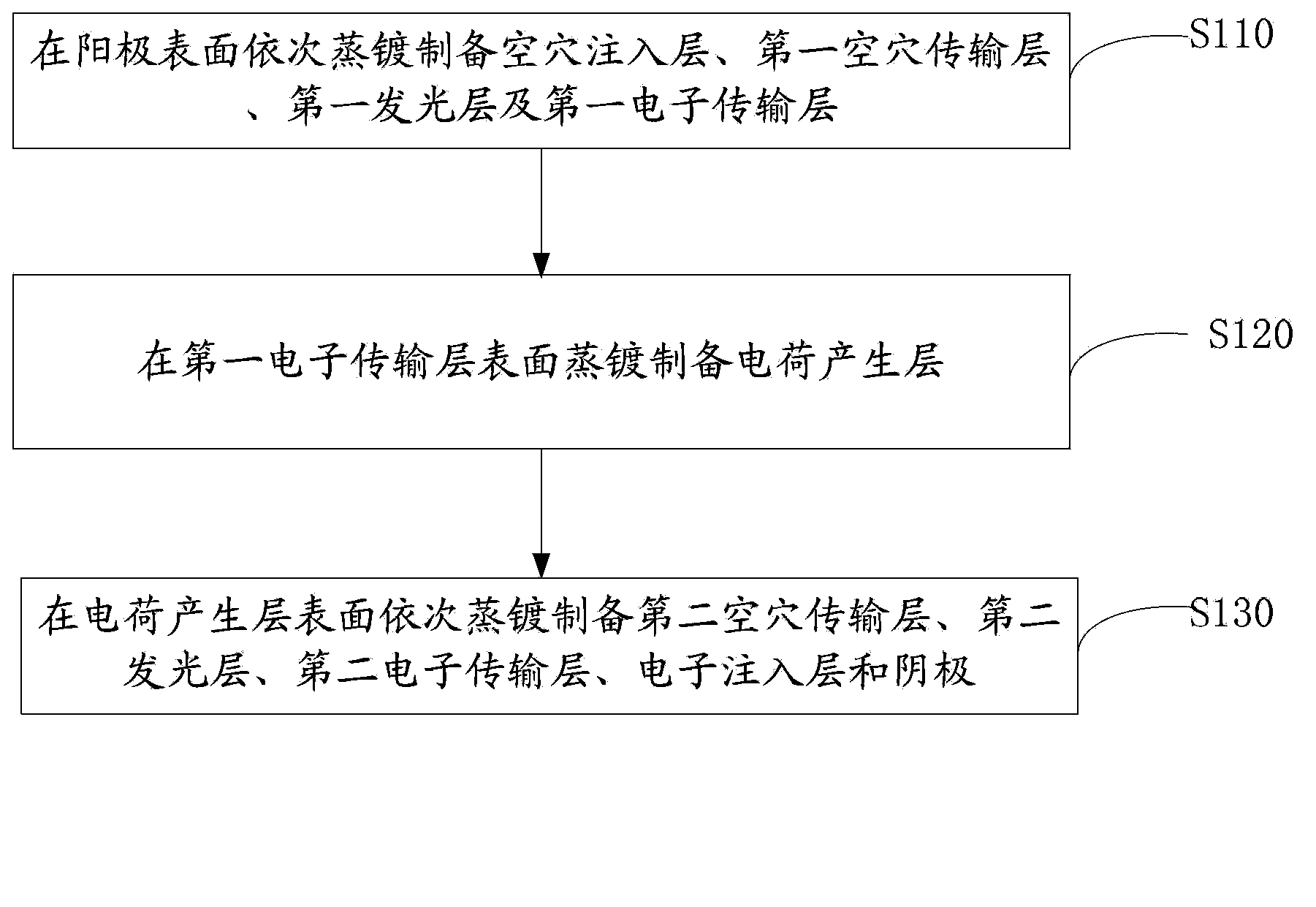Organic light emitting diode and preparation method thereof
An electroluminescent device and luminescence technology, which is applied in the direction of electric solid-state devices, semiconductor/solid-state device manufacturing, electrical components, etc., can solve the problems of low luminous efficiency, improve luminous efficiency, increase film density, and improve electronic components. The effect of transfer rate
- Summary
- Abstract
- Description
- Claims
- Application Information
AI Technical Summary
Problems solved by technology
Method used
Image
Examples
preparation example Construction
[0036] See also figure 2 , The method for manufacturing the organic electroluminescent device 100 of an embodiment includes the following steps:
[0037] In step S110, the hole injection layer 20, the first hole transport layer 32, the first light-emitting layer 34, and the first electron transport layer 36 are prepared by evaporation on the surface of the anode in sequence.
[0038] The anode 10 is indium tin oxide glass (ITO), aluminum zinc oxide glass (AZO), or indium zinc oxide glass (IZO), preferably ITO.
[0039] In this embodiment, the anode 10 is pre-treated before the hole injection layer 20 is formed on the surface of the anode 10. The pre-treatment includes: performing photolithography treatment on the anode 10, cutting it to the required size, and using detergent and deionization. Water, acetone, ethanol, and isoacetone were each ultrasonically cleaned for 15 minutes to remove organic contaminants on the anode 10 surface.
[0040] The hole injection layer 20 is formed on ...
Embodiment 1
[0056] The structure prepared in this embodiment is ITO / V 2 O 5 / NPB / Alq 3 / TPBI / ZnO:Al / MoO 3 / FeCl 3 :HfO 2 / TCTA / Alq 3 / TPBi / Cs 2 CO 3 / Al organic electroluminescent device. Wherein, " / " means a laminated structure, and ":" means doping or mixing, and the following embodiments are the same.
[0057] Firstly, ITO is processed by photolithography and cut to the required size, followed by sonication with detergent, deionized water, acetone, ethanol, and isopropanol for 15 minutes each to remove organic contaminants on the glass surface; vapor-deposit hole injection layer , The material is V 2 O 5 , The thickness is 60nm; the first hole transport layer is vapor-deposited, the material is NPB, the thickness is 40nm; the first light-emitting layer is vapor-deposited, the material is Alq 3 , The thickness is 25nm; the first electron transport layer is vapor-deposited, the material is TPBI, the thickness is 60nm; the charge generation layer is prepared, and the n-type layer is prepared ...
Embodiment 2
[0062] The structure prepared in this example is AZO / WO 3 / TCTA / ADN / TPBi / TiO 2 :Ag / WO 3 / FeBr 3 :HfB 2 / NPB / ADN / TAZ / CsN 3 / Pt organic electroluminescent device.
[0063] First, the AZO glass substrate was used detergent, deionized water, and ultrasonic for 15 minutes to remove organic pollutants on the glass surface; the hole injection layer was prepared by evaporation, and the material was WO 3 , The thickness is 80nm; the first hole transport layer is prepared by vapor deposition, the material is TCTA, the thickness is 60nm; the first light-emitting layer is prepared by vapor deposition, the material is ADN, the thickness is 5nm; the first electron transport layer is prepared by vapor deposition, the material is TPBi, the thickness is 200nm; the charge generation layer is prepared, and the n-type layer is made of TiO by electron beam evaporation 2 :Ag, TiO 2 The mass ratio to Ag is 1:20, the thickness is 20nm, and the material for the intermediate layer prepared by evaporation is...
PUM
| Property | Measurement | Unit |
|---|---|---|
| Thickness | aaaaa | aaaaa |
| Thickness | aaaaa | aaaaa |
| Thickness | aaaaa | aaaaa |
Abstract
Description
Claims
Application Information
 Login to View More
Login to View More - R&D
- Intellectual Property
- Life Sciences
- Materials
- Tech Scout
- Unparalleled Data Quality
- Higher Quality Content
- 60% Fewer Hallucinations
Browse by: Latest US Patents, China's latest patents, Technical Efficacy Thesaurus, Application Domain, Technology Topic, Popular Technical Reports.
© 2025 PatSnap. All rights reserved.Legal|Privacy policy|Modern Slavery Act Transparency Statement|Sitemap|About US| Contact US: help@patsnap.com



